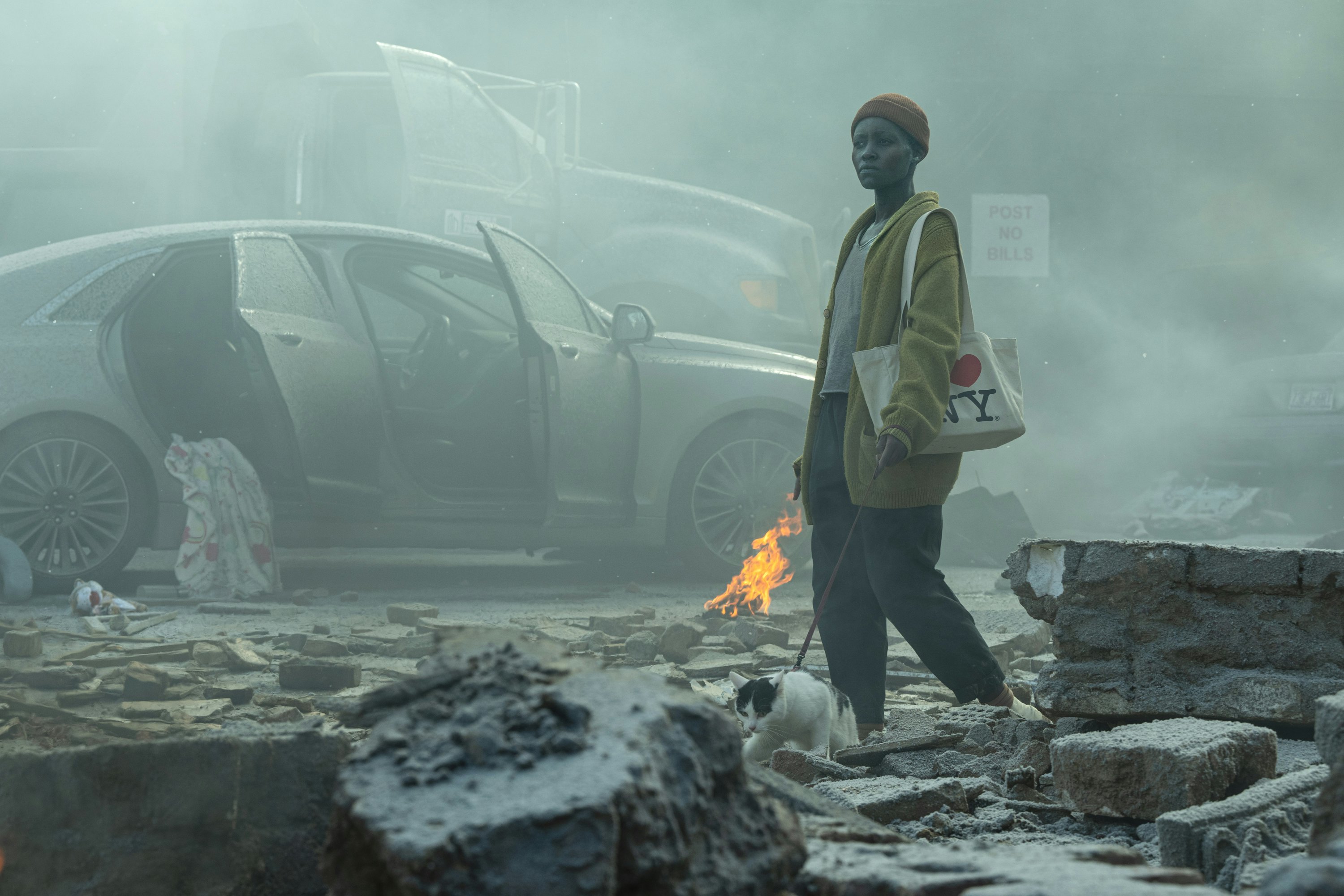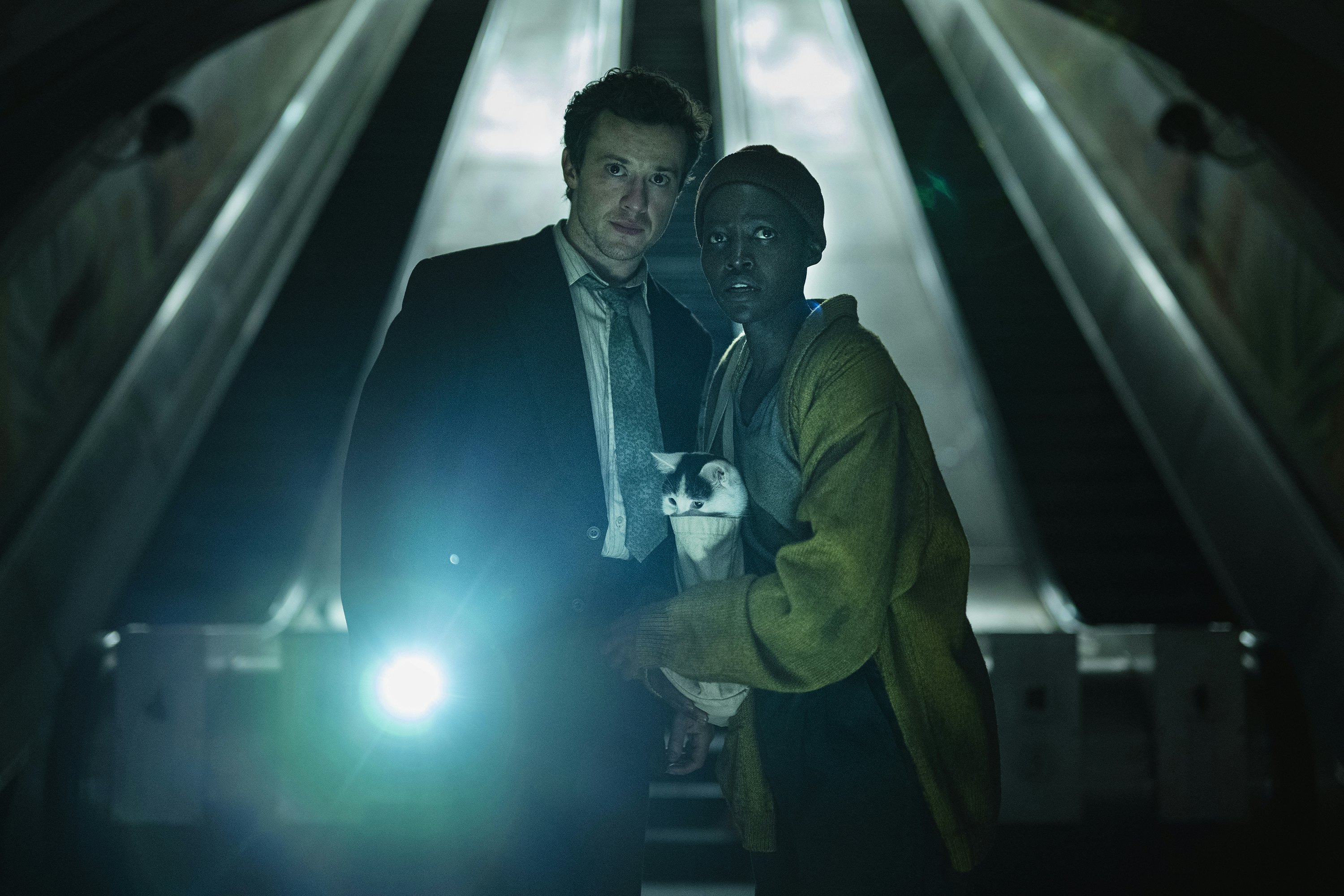
A Quiet Place: Day One begins with a bang, quite literally. When the ailing Sam (Lupita Nyong’o) and her hospice group are brought on an outing to New York City, they are at ground zero for an invasion of bloodthirsty aliens who land in a fiery shower of meteors. What isn’t destroyed by the meteors are ripped apart by the aliens, who immediately begin to attack anything that makes noise.
It’s a spectacular, horrifying opening setpiece — one that was promised, after all, in the title of the film itself: Day One. A prequel to John Krasinski’s A Quiet Place, Day One lives up to its premise of showing the first 24 hours of an alien invasion that kicks off a silent apocalypse where humans live in fear of monsters with super-sensitive hearing. But once the dust settles and an eerie quiet sets in over the city, Day One transforms into a truly singular blockbuster movie that sheds the immersive spectacle of the first movie in favor of something more tender and wistful. It’s an unusual approach for a movie that had been billed as the first part of a world-building initiative for a franchise that seemed like it would have difficulty expanding beyond its gimmick. But director Michael Sarnoski, whose debut feature Pig was also a disarmingly soulful twist on the revenge flick, uses the film’s apocalyptic setting to tell a sweet, humanist story of companionship and loss at the end of the world.

A Quiet Place: Day One opens with Nyong’o’s Sam begrudgingly participating in a group therapy session at her hospice, where she is being treated for a severe type of cancer. Sam is an acerbic and bitter loner, who has to be tricked into going on an outing to New York City by her nurse Reuben (Alex Wolff), the closest person she has to a friend. But she eventually relents at the prospect of getting pizza in the city. Their outing is, of course, cut short by the terrifying attack of the aliens, who cut a bloody swath through the city, leaving only the survivors who were quick to catch on to their hearing-sensitivity quirk. After getting saved by Djimon Hounsou’s Henri — the lone cameo connecting Day One to the greater Quiet Place universe — Sam and her emotional support cat Frodo embark on a deeply personal odyssey through New York City in search of that pizza (there’s an emotionally resonant reason for it, don’t worry). Along the way, she reluctantly gains a traveling companion in Eric (Joseph Quinn, wonderfully vulnerable), a terrified law student with whom she forms a deep and intimate connection.
The conceit of A Quiet Place — you have to be really quiet or you DIE — is not quite as strict in Day One, nor can you expect it to be. The immediate death sentence of making a noise in the previous films isn’t quite as harsh in Day One, with Sam and Eric making a fair few narrow escapes thanks to fast reflexes or lucky breaks. This is the first part of an invasion that renders the whole world into a silent post-apocalyptic landscape, and the film plays out like a pretty standard alien invasion movie. Sarnoski doesn’t have quite the same handle on the kind of immersive action that Krasinski displayed in the first two Quiet Place movies, and it shows: the jumpscares are mostly by-the-book, and the film’s most tense moments are nothing we haven’t seen in horror before. The handful of setpieces littered throughout the film are not without their hair-raising thrills, but Sarnoski doesn’t seem as interested in playing out the “keep quiet” gimmick of the other Quiet Place movies.

Instead, the film focuses more on the novelty of a bustling city like New York — which an opening text card states “operates at 90 decibels… the sound of a human scream” — going completely silent. There are long stretches of the film which are just Sam silently walking through the city, observing the quiet beauty of an abandoned basketball court, picking up used books scattered on the sidewalk, or wandering through a bar that held precious memories of her life. Cinematographer Pat Scola bathes these quiet moments in a warm, naturally-lit glow, with Sarnoski mostly operating in extreme wide shots — showing the city in its vast emptiness — or in intense close-ups of Nyong’o’s beautifully expressive face. It’s as if the movie is not interested in the stakes of the apocalypse, or the lore of these monsters — any bit of worldbuilding is done almost begrudgingly, in short spurts, as if Sarnoski received a studio note to include some bit of mythology-building, and dumps it in a throwaway line or a fleeting scene between character moments.
Instead, it’s the intimate character moments that are the real focus of the movie, with the budding relationship between Sam and Eric becoming the lovely focal point of the film. Brought together by Frodo ( who proves to be a surprisingly resilient, almost supernaturally relaxed, cat), their dynamic plays out almost like a silent romance, with Day One transforming into something of a wistful rom-com set at the end of the world. It’s a wholly unexpected direction for this film to go, but a pleasant one, and speaks to the trust that Sarnoski was given to execute his version of a blockbuster film: one that’s not beholden to lore or mythology, but simply to showing its characters in this unique apocalyptic landscape.

Fans of the first A Quiet Place, who are expecting another breathlessly tense sci-fi horror film, are likely to be disappointed by a blockbuster as reflective and, well, quiet as this. Day One bucks the expectations for what a Quiet Place movie, and really a blockbuster film, should be, and instead delivers something much more moving and poignant. It’s a terrific synthesis of an arthouse director’s vision with franchise filmmaking, and the result is a soulful blockbuster unlike any of its contemporaries.




!["[T]he First and Fifth Amendments Require ICE to Provide Information About the Whereabouts of a Detained Person"](https://images.inkl.com/s3/publisher/cover/212/reason-cover.png?w=600)


